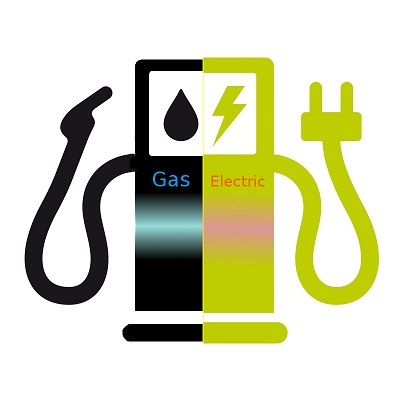Electric For Your EV Is Not Free! Anderson Economic Group Study Showed Total EV Fill-up Costs Higher Than For "Real" Cars
 |
 |
What do you think will happen when potential EV buyers finally wake up from their media and politician induced (not from The Auto Channel) Emperors New Clothes Moment and learn that there is no advantage for them to spend money for an expensive and inconvenient EV, while their good old paid-for ICE powered vehicle, can easily and safely use same-pump ethanol based High Octane Regular which is "cleaner and way cheaper then an EV.
This groundbreaking report should wake up woke car company execs and ignorant politicians, who like lemmings are following each other “over the cliff” eliminating a profitable future for their brands.
Electric vehicles can be more expensive to fuel than their internal combustion engine counterparts
By Patrick L. Anderson, Principal and CEOAlston D’Souza, Senior Analyst
Anderson Economic Group, LLC
East Lansing | Chicago
October 21, 2021
6 months of independent research finds fueling costs for electric vehicles (EV) are often higher than for internal combustion engines (ICE)
 |
This initial 36-page study is the culmination of comprehensive research comparing the “apples-to-apples” costs involved in fueling both EVs and ICE vehicles. AEG undertook this study after noting that many commonly cited figures did not account for the true costs associated with EV charging.
AEG calculated the cost of chargers, additional road taxes, commercial charging fees, and “deadhead” miles for three different EV driving scenarios and compared these with 3 analogous ICE vehicle scenarios. The research found that fueling an EV is often more expensive than fueling an ICE vehicle. It further found that fueling costs are far more variable for EVs. The authors go on to note the significant time costs imposed on EV drivers as a result of both inadequate infrastructure and wait times associated with fueling, which can be five to ten times the cost for ICE drivers.
According to study author Patrick Anderson, “These numbers may be surprising to those who haven’t relied upon an electric vehicle, but it’s important we safeguard the public from ‘charger shock.’ Before consumers can feel comfortable buying EVs in large numbers, they need to understand the true costs involved.”
| Composition of Direct Monetary Costs for Driving 100 Miles |
 |
| Composition of Time Costs for Driving 100 Miles |
 |
Future studies in the EV transition series (available by subscription only) will draw from ongoing research published to the Automotive Dashboard (andersoneconomicgroup.com/automotive-dashboard). This publicly available resource offers a rolling data overview that tracks metrics critical to the auto industry.
Read the full study here.
EV Fueling Cost Comparison Study: Comment Responses, Clarifications, and FAQs (October 25, 2021)
- Shouldn’t the cost of the charger be spread out over multiple years? Indeed, we have amortized the cost of an L1 or L2 charger for each scenario for an EV owner. We vary the assumed usage of home and commercial chargers in each scenario, to represent a range of possible usage situations.As stated in the study, the cost of the gas pump is included in the retail price of gas, so an equivalent comparison requires the inclusion of the charger equipment. That is priced into commercial charging rates, but not residential utility charges.
- Do the calculations take into account the states/utilities/car companies that offer rebates/subsidies/bundled pricing? We acknowledge in our report that states and utilities offer, in some places and under some conditions, rebates and subsidies. We also acknowledge, and state explicitly in the report, that most auto manufacturers “bundle” a minimal set of equipment with the vehicle, and then offer additional charging equipment at additional cost. Of course, the costs of any equipment that is purchased with the car is born by the consumer that purchases it. Thus, properly comparing the cost of fueling requires us to include any equipment purchased for fueling. In addition, OEMs often charge explicitly for home chargers. Examples of OEMs charging for home chargers are Ford and Porsche.As stated in our report, we include the actual costs of charging equipment and charging services because the consumer pays for those costs. Whether they are bundled into the price of the car, bundled into the utility chargers, it is the consumer that pays them. As EVs become more mainstream, it will be harder to hide the implicit pricing of the charging equipment and cost of charging.
- Your assumptions rely on too many drivers charging commercially. Don’t most people charge at home? We show a range of driver charging scenarios, including one for those who mostly charge at home. We also recognize reality: most people drive their cars away from their homes at least occasionally and will therefore require commercial charging at some point. Further, a substantial portion of the US population does not own a residence, and therefore will have difficulty installing or accessing a residential charger. As EVs become mainstream, this large share of the population must be considered.
- Did oil companies, auto manufacturers, or other interest groups pay for this study? In circumstances where an organization commissioned our work, we state that explicitly. In this case, the work was done independently. This study is the result of over 6 months of independent work by consultants at Anderson Economic Group. The company has over two decades of work for clients that include auto manufacturers, trade associations, auto dealers, labor unions, state governments, municipalities, colleges, and nonprofit organizations, including organizations that promote conservation and energy efficiency. No outside group provided support for this analysis, financial or otherwise.
- Does it really take 90 hours to charge a car with a home charger? The “90 hour” photograph shown in the Free Press article is a true and accurate record of an actual home charging session, as stated in the photo caption. Although not stated in the article, Ford Motor Company lists 95 hours of charging with a home charger as an estimate of the time required for people relying on standard household outlets.Although the picture and the Ford description are accurate, we do not assume that EV owners rely solely on home chargers, or that they always or even primarily use commercial chargers. We present multiple scenarios for charging, as noted above, to illustrate the range of possibilities.
- Don’t EV drivers charge at home 90% of the time? Even if drivers charge at home 90% of the time (an optimistic scenario, but possible), it doesn’t mean they get 90% of their power from residential chargers. A proper cost comparison, which we did, is based on the amount of power purchased (and the equipment, taxes, and mileage associated with it), not the frequency of use. For example, a driver may charge nine times at a home charger to add a total of 72 kW to their battery (at 8 kW added per session that could take about 10 hours on a home charger). The same driver may then make one longer trip, stopping at a commercial charger to add 70 kW. In this scenario, the driver charges at home 90% of the time but still uses about 50% commercial and 50% residential charging power.Drivers who use their EV for local use only may be able to use a residential charger for an entire month, thus 100% paying residential utility rates.
- Many ICE vehicles get better mileage than used in your study’s calculations. Does that make your results wrong? Just like the range of situations for EV drivers, ICE vehicle drivers also have a range of outcomes. We considered a range of these in our study and based our findings on typical results, but obviously we cannot account for every conceivable scenario. One such situation would certainly involve lower costs than we displayed for the ICE scenarios in our Oct 2021 report.
- Shouldn’t you have included oil changes, software updates, maintenance costs, battery replacement, insurance costs, etc.? Our October 2021 report, as the title says, is about the cost of fueling EVs and ICE vehicles. We did not include maintenance costs for either EVs or ICE vehicles. Similarly, we did not include depreciation, insurance costs, or other expenses not related to energy. Later studies may cover some or all of these items.Although we did not include maintenance expenses for either type of vehicle in this cost comparison, it is worth noting that EVs do require maintenance. Most analyses suggest that the maintenance costs are likely to be less than for ICE vehicles, but not zero.
- ICE drivers also have to drive out of their way to get to gas stations. Yes, drivers must drive to a gas station as well as to a commercial EV charging station. Because of this, we include “deadhead” miles for both EV and ICE drivers, with the number of miles for EV drivers dependent on their usage of commercial rather than residential chargers. As stated in the text, we make use of data on the number of gasoline stations and the number of fast DC charging stations, as of mid-2021, to provide indicative distances for residents in metropolitan areas of the US. As stated in the text, there is a very big variation in convenience for EV chargers and gasoline stations across the United States. For some drivers, especially those in rural areas, getting to either a charger or a gas station may take more time and more miles than the scenarios we describe in the October 2021 report.
- Aren’t public and private EV chargers/charging services really free? As stated in our report, we include the actual costs of charging equipment and charging services because the consumer pays for these costs. Whether they are bundled into the price of the car or passed along via utility charges, the consumer ultimately pays for them.Just like “free parking” at a store, “free popcorn” at a movie theater, and “free coffee” at an employer, the cost may be hidden to some extent by the entity subsidizing it, but that does not erase the costs. Retailers may charge more for products, employers may pay less in wages, but the cost will be passed on to the consumer in the end.
- Can’t EV drivers just use a 110 VAC home outlet? Why do you include the price of a “charger?” Plug-in EVs typically take a J1772 plug, which is not the same as a 110 VAC 15 amp 2-pin (or 3-pin) circuit. Thus, EV drivers need some additional equipment that is typically called a “charger.”
- Ford sells a $799 “connected charge station:”
https://www.ford.com/buy-site-wide-content/overlays/mach-e-overlays/ford-connected-charge-station/- Tesla’s least expensive charger is listed at $500:
https://shop.tesla.com/product/wall-connector—24-ft?tesref=true- Further, as stated on both sites and noted in our report, the cost of the charger doesn’t include the cost of an electrician to install it.
- Charging is not that expensive. There is a commercial charger near me that advertises just $0.10. Commercial chargers price power in a variety of ways, as correctly noted in our report. Some readers confuse price per minute with price per kilowatt. In this scenario, the charge was for 10 cents a minute the first hour, then 20 cents per minute after that. At 20 cents per minute, the driver pays $12 per hour. A driver who gets only 12 kW in that hour pays $1 a kilowatt, one who gets 24 kW pays 50 cents per kilowatt, and one who gets 36 kW pays 30 cents per kW. The charger doesn’t (and cannot) guarantee a price based upon kW, as the EV itself may throttle the charging rate. Many EV drivers report having observed throttles taking place on public forums, citing maximum (not average) charging rates ranging from 26kW to 56kW to 125kW for the same commercial charger.


